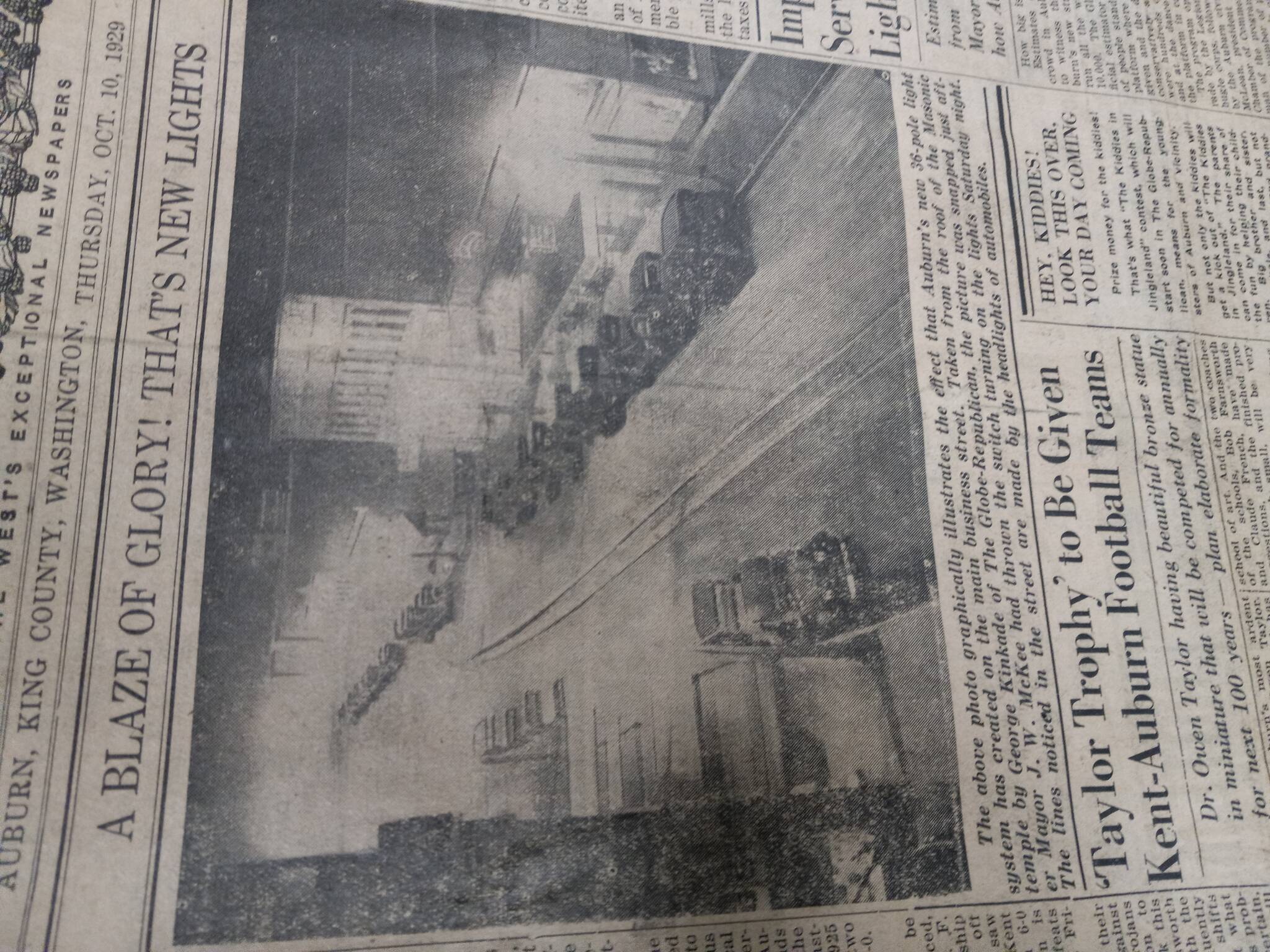October of 1929 would prove to be important in the lives of Auburn residents, though it would take time to determine just how important.
Here’s what the old Auburn-Globe Republican had to say about that month in its chronicling of matters momentous and minute.
The 10th month of that year started out with a big, big deal in Auburn: the dedication of the new, $7,000 ornamental street lighting system on Saturday, Oct. 5.
“Thousands expected here,” an article predicted on the front page of the Oct. 3 edition.
And thousands did come, eager to participate in the doings. The multitude would no doubt have included many purchasers of the 30,000 tickets that had been issued for the big prize drawing Saturday night.
“Interest Running High,” said a headline.
Auburn Post and University Post American Legion Drum and Bugle Corps kicked off Saturday’s festivities at 6:45 p.m., followed by the inevitable, dignatarial speechifying and bloviating, issuing from the mouths of local big wigs.
The city had arranged for downtown merchants to turn off their display window lights, throwing the street into total darkness just before the big moment.
At 7:27 p.m. with “one long blast of a fire siren,” Mayor J.W. McKee threw the switch, flooding the downtown with light. Oohs and ahhs weren’t on the schedule, of course, but there must have been many. Within moments, merchants flipped on their shop lights again, and a new era began in the downtown.
There would be more to celebrate that night. Later, attendees hoofed a free dance in the downtown. In the event of rain, the American Legion was prepared to offer its hall on West Main and F Street.
At 11 p.m., the paper recorded, there was a ”Big frolic at Granada Theater, with 170 prizes given away.”
A photo with the kicker, “Blaze of Glory,” appeared in the Oct. 5 paper, “graphically illustrat(ing) the effect that Auburn’s new 36 pole light system has created on the main business street. Taken from the roof of the Masonic Temple by George Kinkade of the Globe Republican, the picture was snapped just after Mayor J.W. McKee had thrown the switch turning on the lights Saturday Night.”
Of course, other events would make it an October to remember.
The city’s plan to install water meters all over town was a topic of much discussion, as were the upcoming city council elections, and the city’s plan to tackle the 1930 budget on Oct. 7.
On Friday, Oct. 4, the Taylor Trophy was to be awarded at the Auburn-Kent football game. But one key person would be missing from the ranks of the Auburn boys. Seems that the AHS football team’s captain had cracked his ribs in a match the previous week with the Bremerton bruise boys, and would be unavailable to play, per order of Coach Farnsworth.
“Injuries Keep Allerdice Out” and “…Scrappy little captain will watch Hiline game from bench Friday,” said the headline, using the former spelling for Highline.
That month, Auburn High School’s junior class staged its big fall play, as the paper teased: “Want a little real romance? The Junior play will be full of it.”
At the Granada Theater, stars of the day, Hal Skelly and Nancy Carroll, were appearing in the Paramount Picture “The Dance of Life.”
October would also be the month a Mr. H.J. Babb found enough money in his pocket to make himself the proud owner of a shiny new Ford Coupe, thumbing his ears at the siren song of “The Valley Motor Company, George Sparks Manager,” with its used 1927 Ford Coupe for $250 and its 1926 Hudson Brougham for $585.
Sunset Laundry boldly guaranteed that for a mere 75 cents, bathing suits would be “Washed and Konated, guaranteed absolutely Moth Free.” Konation was the process used to moth-proof a garment.
“Backache, burning or itching sensation in the leg or groin, pains make you feel old tired pepless and worn out? Why not make the Cystex 48 hour test?” inquired one advertisement.
In a regular front-page item, Hectic Hazel cracked that Santa Claus “was the only man interested in girls’ stockings when there was nothing in them.”
But the paper also casually chronicled the fierce racism of the time.
Seems the Auburndale community said it had been put in a bad light by an article that appeared in the paper the week before, wherein one George Summers, “a negro in that vicinity,” looking into circumstances concerning the burning of his home, complained that his investigation had been stymied by law enforcement and by his neighbors’ rebuffs and slammed doors.
“The people of Auburndale say that it is generally known no such attitude was shown toward the darky and that his report is without foundation and has created a bad impression,” the write-up said.
For most people, however, the good times were rolling. Credit was easy to obtain. For the first time, millions of ordinary Americans were able to buy stocks on margin — that is, with money borrowed from banks.
The Great Depression began on Black Tuesday, Oct. 29, 1929, 24 days after Auburn’s big shindig. The first big event locally was a 2-day run on the Auburn National Bank on the following Friday and Saturday.
“First National Bank Closed after Panic: Uneasy depositors are cause of run on local institution,” said a front-page article.
Ironic that just as the lights came on in Auburn, they were about to go off again, here and elsewhere.
–




